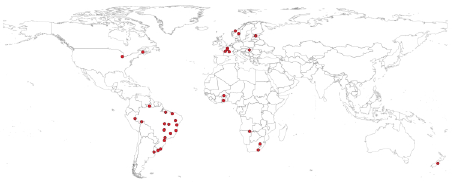C-arouNd
| Start: | 3rd May, 2023 |
| Duration: | 36 |
| Title: | C-arouNd: Refining Soil Conservation and Regenerative Practices to Enhance Carbon Sequestration and Reduce Greenhouse Gas Emissions |
| Aim: | C-arouNd aims to investigate how short and long-term agricultural management practices affect SOM persistence in the soil profile and contribute to inclusion of the effects in national inventories to inform policy to reduce net greenhouse gas emissions and mitigate global change. C-arouNd also aims to synthesize findings from a worldwide consortium of long-term agricultural field experiments with focus on soil organic matter sequestration and persistence. |
| Keywords: | soil carbon persistence, agriculture intensification, sustainable development, nutrients cycling, carbon storage |
| Contact: | PI: Mellissa Ananias Soler da Silva, Brazilian Agricultural Research Corporation - Embrapa (mellissa.soler@embrapa.br) Co-PI: Abad Chabbi, INRAE (abad.chabbi@inrae.fr) |
| Twitter: |

With the use of inorganic fertilizers, plant breeding and pesticides, global food production more than tripled in the last 60 years, reducing hunger and poverty by fulfilling the Sustainable Development Goals from the UN 2030 Agenda. However, this progress came at a cost because soil degradation resulted in a reduction of soil organic carbon (SOC) stocks and an increase in greenhouse gas (GHG) emissions and global warming.
Agriculture and land use change are held responsible for almost 20% of global GHG emissions, and is one of the most significant sources of nitrous oxide (N2O) due to application of synthetic nitrogen fertilizers, and methane (CH4), due to livestock activity and paddy rice cropping. Agricultural practices that increase soil C stocks and reduce GHG emissions are desirable strategies for the mitigation of global warming, and international initiatives have been launched as 4per1000 at the COP21 meeting in Paris (2015), to promote agricultural practices that increase soil C stocks as a global warming mitigation strategy. Moreover, increasing SOC will have positive effects on agricultural production due to increase nutrients and water cycling, and on soil health due to its positive relationship with soil biodiversity.
The objective of this proposal is to evaluate the influence of conservationist and regenerative agricultural practices on carbon (C), nitrogen (N) and phosphorus (P) cycling, soil biodiversity and GHG emissions with a particular emphasis on long-term SOC stocks, and processes governing C persistence. This project represents an exploratory effort to couple the stoichiometric drivers to microbial populations related to C, N, and P cycling and stocks, and GHG emission under diverse agricultural practices.
For this, we are establishing a consortium of long-term field experiments that evaluate the impact of different cropping systems and agricultural practices on soil properties. There are participants from 12 different countries with a total of 37 field sites with different chrono-sequences or contrasting agricultural management. At 26 sites established for at least 10 years.
At each site, estimates and scenarios modeling of possible emissions of N2O, CO2 and CH4 from the cropping/pasture/forest systems will be made using the best-available IPCC or local emission factors and GHG emissions will be measured at a subset of sites. To compare the impact of different climatic and edaphic conditions among sites, we propose a standard soil organic matter (OM) physical fractionation procedure resulting in two contrasting soil fractions including particulate organic matter (POM), which consists mainly of partially decomposed plant residues, and the mineral-associated OM (MAOM), principally of microbial origin.
This project will build a worldwide database of C and N stocks, bulk density, soil fertility and GHG emissions across different ecosystems and under differential agricultural management.
Furthermore, the project will determine to what extent climatic conditions, net primary production of the cropping systems and soil type affect C and N stocks, nutrient dynamics and GHG emissions.
The final product of the project will be to recommend best management practices for production of food crops which would promote soil C accumulation, especially MAOM, without increasing GHG emissions thus contributing to the sustainability and resilience of agriculture.

Project partners
Country | Organization |
Canada | Agriculture and Agri-Food Canada |
Uruguay | Instituto Nacional de Investigación Agropecuaria (INIA) |
South Africa | Agricultural Research Council - Natural Resources & Engineering |
Namibia | University of Namibia |
Ghana | Kwame Nkrumah University of Science and Technology (KNUST) |
Estonia | Estonian Research Institute |
Hungary | Hungarian University of Agriculture and Life Sciences |
France | L’institut national de recherche pour l'agriculture, l'alimentation et l'environnement (INRAE) |
Norway | Norwegian Centre for Organic Agriculture |
Norway | NIBIO |
New Zealand | Manaaki Whenua Landcare Research |
Germany | Leibniz Centre for Agricultural Landscape Research (ZALF) |